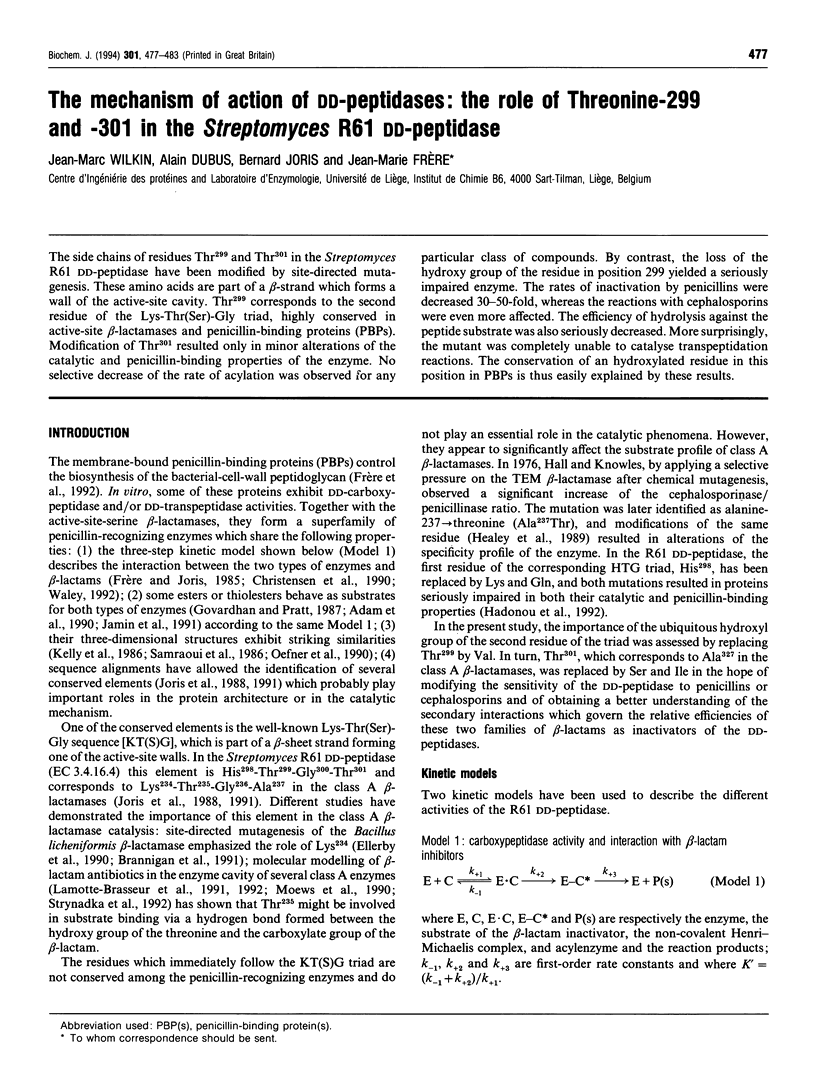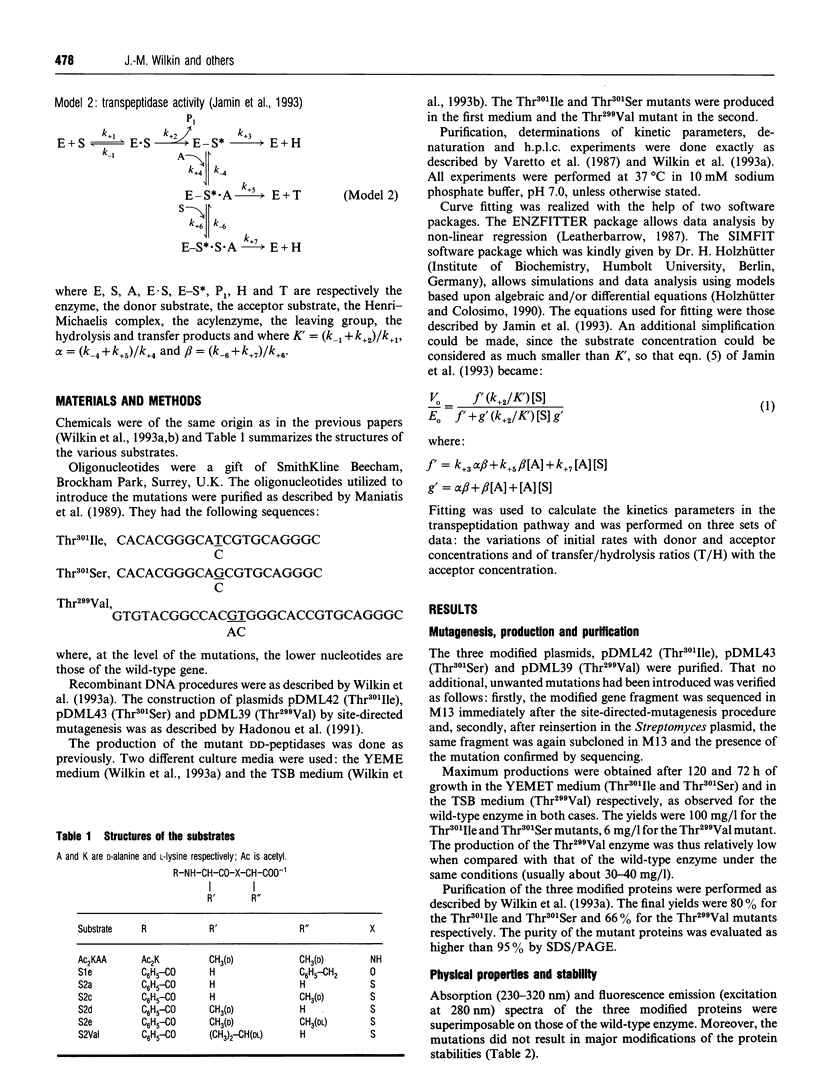Abstract
The side chains of residues Thr299 and Thr301 in the Streptomyces R61 DD-peptidase have been modified by site-directed mutagenesis. These amino acids are part of a beta-strand which forms a wall of the active-site cavity. Thr299 corresponds to the second residue of the Lys-Thr(Ser)-Gly triad, highly conserved in active-site beta-lactamases and penicillin-binding proteins (PBPs). Modification of Thr301 resulted only in minor alterations of the catalytic and penicillin-binding properties of the enzyme. No selective decrease of the rate of acylation was observed for any particular class of compounds. By contrast, the loss of the hydroxy group of the residue in position 299 yielded a seriously impaired enzyme. The rates of inactivation by penicillins were decreased 30-50-fold, whereas the reactions with cephalosporins were even more affected. The efficiency of hydrolysis against the peptide substrate was also seriously decreased. More surprisingly, the mutant was completely unable to catalyse transpeptidation reactions. The conservation of an hydroxylated residue in this position in PBPs is thus easily explained by these results.
Full text
PDF






Selected References
These references are in PubMed. This may not be the complete list of references from this article.
- Adam M., Damblon C., Plaitin B., Christiaens L., Frère J. M. Chromogenic depsipeptide substrates for beta-lactamases and penicillin-sensitive DD-peptidases. Biochem J. 1990 Sep 1;270(2):525–529. doi: 10.1042/bj2700525. [DOI] [PMC free article] [PubMed] [Google Scholar]
- Brannigan J., Matagne A., Jacob F., Damblon C., Joris B., Klein D., Spratt B. G., Frère J. M. The mutation Lys234His yields a class A beta-lactamase with a novel pH-dependence. Biochem J. 1991 Sep 15;278(Pt 3):673–678. doi: 10.1042/bj2780673. [DOI] [PMC free article] [PubMed] [Google Scholar]
- Christensen H., Martin M. T., Waley S. G. Beta-lactamases as fully efficient enzymes. Determination of all the rate constants in the acyl-enzyme mechanism. Biochem J. 1990 Mar 15;266(3):853–861. [PMC free article] [PubMed] [Google Scholar]
- De Meester F., Joris B., Reckinger G., Bellefroid-Bourguignon C., Frère J. M., Waley S. G. Automated analysis of enzyme inactivation phenomena. Application to beta-lactamases and DD-peptidases. Biochem Pharmacol. 1987 Jul 15;36(14):2393–2403. doi: 10.1016/0006-2952(87)90609-5. [DOI] [PubMed] [Google Scholar]
- Dubus A., Wilkin J. M., Raquet X., Normark S., Frère J. M. Catalytic mechanism of active-site serine beta-lactamases: role of the conserved hydroxy group of the Lys-Thr(Ser)-Gly triad. Biochem J. 1994 Jul 15;301(Pt 2):485–494. doi: 10.1042/bj3010485. [DOI] [PMC free article] [PubMed] [Google Scholar]
- Ellerby L. M., Escobar W. A., Fink A. L., Mitchinson C., Wells J. A. The role of lysine-234 in beta-lactamase catalysis probed by site-directed mutagenesis. Biochemistry. 1990 Jun 19;29(24):5797–5806. doi: 10.1021/bi00476a022. [DOI] [PubMed] [Google Scholar]
- Frère J. M., Joris B. Penicillin-sensitive enzymes in peptidoglycan biosynthesis. Crit Rev Microbiol. 1985;11(4):299–396. doi: 10.3109/10408418409105906. [DOI] [PubMed] [Google Scholar]
- Govardhan C. P., Pratt R. F. Kinetics and mechanism of the serine beta-lactamase catalyzed hydrolysis of depsipeptides. Biochemistry. 1987 Jun 16;26(12):3385–3395. doi: 10.1021/bi00386a021. [DOI] [PubMed] [Google Scholar]
- Hadonou A. M., Jamin M., Adam M., Joris B., Dusart J., Ghuysen J. M., Frère J. M. Importance of the His-298 residue in the catalytic mechanism of the Streptomyces R61 extracellular DD-peptidase. Biochem J. 1992 Mar 1;282(Pt 2):495–500. doi: 10.1042/bj2820495. [DOI] [PMC free article] [PubMed] [Google Scholar]
- Hall A., Knowles J. R. Directed selective pressure on a beta-lactamase to analyse molecular changes involved in development of enzyme function. Nature. 1976 Dec 23;264(5588):803–804. doi: 10.1038/264803a0. [DOI] [PubMed] [Google Scholar]
- Healey W. J., Labgold M. R., Richards J. H. Substrate specificities in class A beta-lactamases: preference for penams vs. cephems. The role of residue 237. Proteins. 1989;6(3):275–283. doi: 10.1002/prot.340060310. [DOI] [PubMed] [Google Scholar]
- Holzhütter H. G., Colosimo A. SIMFIT: a microcomputer software-toolkit for modelistic studies in biochemistry. Comput Appl Biosci. 1990 Jan;6(1):23–28. doi: 10.1093/bioinformatics/6.1.23. [DOI] [PubMed] [Google Scholar]
- Jamin M., Adam M., Damblon C., Christiaens L., Frère J. M. Accumulation of acyl-enzyme in DD-peptidase-catalysed reactions with analogues of peptide substrates. Biochem J. 1991 Dec 1;280(Pt 2):499–506. doi: 10.1042/bj2800499. [DOI] [PMC free article] [PubMed] [Google Scholar]
- Jamin M., Wilkin J. M., Frère J. M. A new kinetic mechanism for the concomitant hydrolysis and transfer reactions catalyzed by bacterial DD-peptidases. Biochemistry. 1993 Jul 20;32(28):7278–7285. doi: 10.1021/bi00079a026. [DOI] [PubMed] [Google Scholar]
- Joris B., Ghuysen J. M., Dive G., Renard A., Dideberg O., Charlier P., Frère J. M., Kelly J. A., Boyington J. C., Moews P. C. The active-site-serine penicillin-recognizing enzymes as members of the Streptomyces R61 DD-peptidase family. Biochem J. 1988 Mar 1;250(2):313–324. doi: 10.1042/bj2500313. [DOI] [PMC free article] [PubMed] [Google Scholar]
- Joris B., Ledent P., Dideberg O., Fonzé E., Lamotte-Brasseur J., Kelly J. A., Ghuysen J. M., Frère J. M. Comparison of the sequences of class A beta-lactamases and of the secondary structure elements of penicillin-recognizing proteins. Antimicrob Agents Chemother. 1991 Nov;35(11):2294–2301. doi: 10.1128/aac.35.11.2294. [DOI] [PMC free article] [PubMed] [Google Scholar]
- Kelly J. A., Dideberg O., Charlier P., Wery J. P., Libert M., Moews P. C., Knox J. R., Duez C., Fraipont C., Joris B. On the origin of bacterial resistance to penicillin: comparison of a beta-lactamase and a penicillin target. Science. 1986 Mar 21;231(4744):1429–1431. doi: 10.1126/science.3082007. [DOI] [PubMed] [Google Scholar]
- Kelly J. A., Knox J. R., Zhao H., Frère J. M., Ghaysen J. M. Crystallographic mapping of beta-lactams bound to a D-alanyl-D-alanine peptidase target enzyme. J Mol Biol. 1989 Sep 20;209(2):281–295. doi: 10.1016/0022-2836(89)90277-5. [DOI] [PubMed] [Google Scholar]
- Lamotte-Brasseur J., Dive G., Dideberg O., Charlier P., Frère J. M., Ghuysen J. M. Mechanism of acyl transfer by the class A serine beta-lactamase of Streptomyces albus G. Biochem J. 1991 Oct 1;279(Pt 1):213–221. doi: 10.1042/bj2790213. [DOI] [PMC free article] [PubMed] [Google Scholar]
- Lamotte-Brasseur J., Jacob-Dubuisson F., Dive G., Frère J. M., Ghuysen J. M. Streptomyces albus G serine beta-lactamase. Probing of the catalytic mechanism via molecular modelling of mutant enzymes. Biochem J. 1992 Feb 15;282(Pt 1):189–195. doi: 10.1042/bj2820189. [DOI] [PMC free article] [PubMed] [Google Scholar]
- Moews P. C., Knox J. R., Dideberg O., Charlier P., Frère J. M. Beta-lactamase of Bacillus licheniformis 749/C at 2 A resolution. Proteins. 1990;7(2):156–171. doi: 10.1002/prot.340070205. [DOI] [PubMed] [Google Scholar]
- Oefner C., D'Arcy A., Daly J. J., Gubernator K., Charnas R. L., Heinze I., Hubschwerlen C., Winkler F. K. Refined crystal structure of beta-lactamase from Citrobacter freundii indicates a mechanism for beta-lactam hydrolysis. Nature. 1990 Jan 18;343(6255):284–288. doi: 10.1038/343284a0. [DOI] [PubMed] [Google Scholar]
- Samraoui B., Sutton B. J., Todd R. J., Artymiuk P. J., Waley S. G., Phillips D. C. Tertiary structural similarity between a class A beta-lactamase and a penicillin-sensitive D-alanyl carboxypeptidase-transpeptidase. 1986 Mar 27-Apr 2Nature. 320(6060):378–380. doi: 10.1038/320378a0. [DOI] [PubMed] [Google Scholar]
- Strynadka N. C., Adachi H., Jensen S. E., Johns K., Sielecki A., Betzel C., Sutoh K., James M. N. Molecular structure of the acyl-enzyme intermediate in beta-lactam hydrolysis at 1.7 A resolution. Nature. 1992 Oct 22;359(6397):700–705. doi: 10.1038/359700a0. [DOI] [PubMed] [Google Scholar]
- Varetto L., De Meester F., Monnaie D., Marchand-Brynaert J., Dive G., Jacob F., Frère J. M. The importance of the negative charge of beta-lactam compounds in the interactions with active-site serine DD-peptidases and beta-lactamases. Biochem J. 1991 Sep 15;278(Pt 3):801–807. doi: 10.1042/bj2780801. [DOI] [PMC free article] [PubMed] [Google Scholar]
- Varetto L., Frère J. M., Nguyen-Distèche M., Ghuysen J. M., Houssier C. The pH dependence of the active-site serine DD-peptidase of Streptomyces R61. Eur J Biochem. 1987 Feb 2;162(3):525–531. doi: 10.1111/j.1432-1033.1987.tb10671.x. [DOI] [PubMed] [Google Scholar]
- Wilkin J. M., Jamin M., Damblon C., Zhao G. H., Joris B., Duez C., Frère J. M. The mechanism of action of DD-peptidases: the role of tyrosine-159 in the Streptomyces R61 DD-peptidase. Biochem J. 1993 Apr 15;291(Pt 2):537–544. doi: 10.1042/bj2910537. [DOI] [PMC free article] [PubMed] [Google Scholar]
- Wilkin J. M., Jamin M., Joris B., Frere J. M. Mechanism of action of DD-peptidases: role of asparagine-161 in the Streptomyces R61 DD-peptidase. Biochem J. 1993 Jul 1;293(Pt 1):195–201. doi: 10.1042/bj2930195. [DOI] [PMC free article] [PubMed] [Google Scholar]


